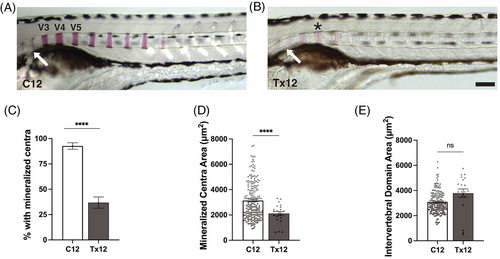Fig. 7
- ID
- ZDB-FIG-231102-36
- Publication
- Sargent et al., 2023 - Regenerative potential and limitations in a zebrafish model of hyperglycemia-induced nerve degeneration
- Other Figures
- All Figure Page
- Back to All Figure Page
|
Acute hyperglycemia impairs vertebral mineralization. (A and B) Lateral view of C12 and Tx12 zebrafish stained with alizarin red solution. Mineralization of vertebrae occurs anterior to posteriorly with vertebrae 3 to 5 (V3-5) mineralizing first. Mineralization of vertebrae in C12 fish (A) progressed further posteriorly than Tx12 fish (B). C12 fish also have begun mineralization of vertebrae 1 and 2, which occurs after a sufficient amount of the vertebral column is mineralized (A, arrow). Tx12 fish with mineralized vertebrae have lighter alizarin red staining in V3-5 (B, asterisk) and even fainter staining of vertebrae 1 and 2 (B, arrow). (C) Tx12 fish were significantly less likely to have any mineralized centra present compared to C12 fish, ****P < .0001. (D) Mineralized V3-5 that were present in Tx12 fish had significantly reduced areas compared to C12, ****P < .0001. (E) The area of intervertebral domain (IVD) adjacent to V3-5 were not different between Tx12 and C12 fish as this time point is earlier than stages of vertebral development in which the centra expand into the IVD, P = .0563. All values are means ± SEM. Scale bar = 100 μm. |

